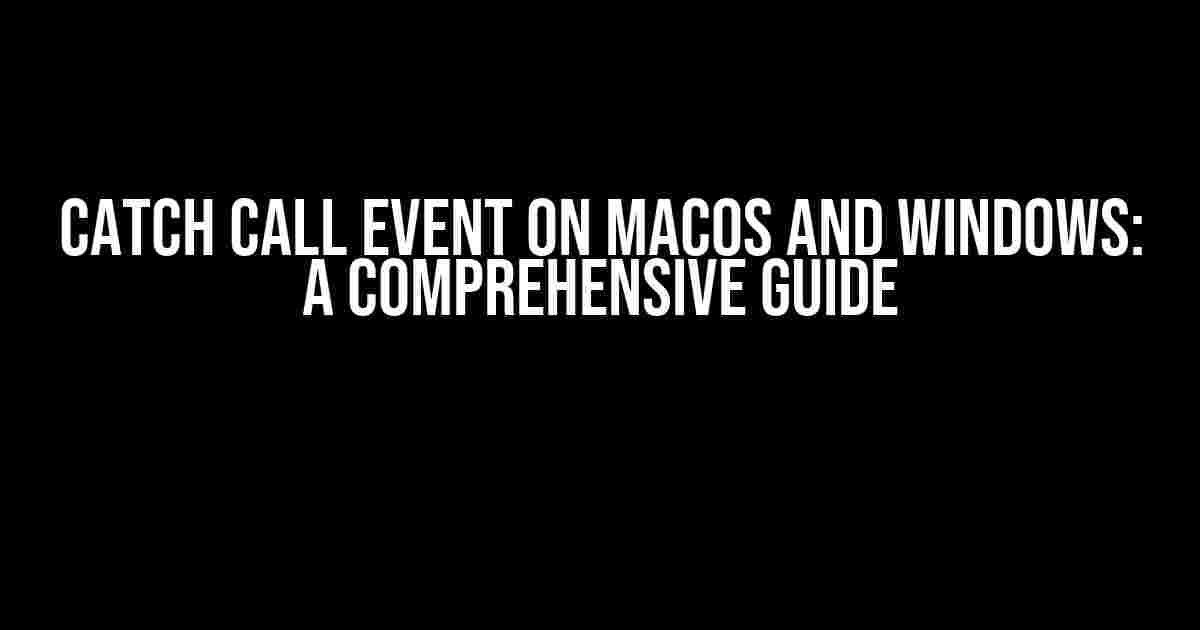Are you tired of missing important calls because your system didn’t notify you? Do you want to create an application that can detect and respond to incoming calls? Look no further! In this article, we’ll explore how to catch call events on both macOS and Windows platforms. Buckle up, and let’s dive in!
- Prerequisites
- Step 1: Import the Core Telephony Framework
- Step 2: Create an Instance of CTCallCenter
- Step 3: Set the CallEventHandler Delegate
- Step 4: Implement the CallEventHandler Delegate Methods
- Step 1: Add the Windows 10 API NuGet Package
- Step 2: Create an Instance of the CallManager
- Step 3: Add an Event Handler for CallStateChanged
- Comparison of macOS and Windows Implementations
- Conclusion
Prerequisites
Before we begin, make sure you have the following:
- A computer running macOS or Windows
- A programming language of your choice (we’ll use Swift for macOS and C# for Windows)
- A basic understanding of programming concepts
The Core Telephony framework provides APIs for interacting with the telephony capabilities of an iOS or macOS device. To catch call events on macOS, we’ll use the CTCallCenter class.
Step 1: Import the Core Telephony Framework
In your Swift project, add the following line to import the Core Telephony framework:
import CoreTelephonyStep 2: Create an Instance of CTCallCenter
Create an instance of the CTCallCenter class:
let callCenter = CTCallCenter()Step 3: Set the CallEventHandler Delegate
Set the CallEventHandler delegate to receive notifications about call events:
callCenter.setCallEventHandler(delegate: self) { (error) in
if let error = error {
print("Error setting call event handler: \(error)")
}
}Step 4: Implement the CallEventHandler Delegate Methods
Implement the callEventHandler method to catch call events:
func callEventHandler(_ call: CTCall!) {
switch call.callState {
case .connected:
print("Call connected")
case .disconnected:
print("Call disconnected")
case .incoming:
print("Incoming call")
default:
print("Unknown call state")
}
}On Windows, we’ll use the Windows 10 API to catch call events. Specifically, we’ll use the Windows.ApplicationModel.Calls namespace.
Step 1: Add the Windows 10 API NuGet Package
In your C# project, add the Windows 10 API NuGet package:
Install-Package Microsoft.Windows.SDK.NETStep 2: Create an Instance of the CallManager
Create an instance of the CallManager class:
var callManager = CallManager.RequestAsync().GetResults()}Step 3: Add an Event Handler for CallStateChanged
Add an event handler for the CallStateChanged event:
callManager.CallStateChanged += (sender, args) => {
switch (args.Call.State) {
case CallState.Incoming:
Console.WriteLine("Incoming call");
break;
case CallState.Connected:
Console.WriteLine("Call connected");
break;
case CallState.Disconnected:
Console.WriteLine("Call disconnected");
break;
default:
Console.WriteLine("Unknown call state");
break;
}
};Comparison of macOS and Windows Implementations
Now that we’ve explored how to catch call events on both macOS and Windows, let’s compare the two implementations:
| Platform | Framework/ API | Programming Language |
|---|---|---|
| macOS | Core Telephony | Swift |
| Windows | Windows 10 API | C# |
Both implementations provide a way to catch call events, but they differ in their approach and API design. The Core Telephony framework on macOS provides a more low-level API, whereas the Windows 10 API provides a higher-level API with more built-in functionality.
Conclusion
In this article, we’ve explored how to catch call events on both macOS and Windows platforms. By following the steps outlined above, you can create applications that detect and respond to incoming calls. Remember to choose the right framework and programming language for your platform, and don’t hesitate to reach out if you have any questions or need further assistance.
Happy coding!
Here are 5 Questions and Answers about “Catch call event on macOS and Windows”:
Frequently Asked Question
Catching call events on macOS and Windows can be a bit tricky, but don’t worry, we’ve got you covered! Here are some frequently asked questions to help you get started.
How can I catch call events on macOS?
To catch call events on macOS, you can use the CoreTelephony framework, which provides calls-related APIs. Specifically, you’ll need to use the CTCallCenter class to monitor call events, such as call setup, disconnect, and call state changes. You can also use the CTCall class to get more information about the call, like the caller’s phone number.
What is the equivalent of CoreTelephony on Windows?
On Windows, you can use the Windows.Telephony.Dialer API to catch call events. This API provides events for call state changes, such as CallStateChanged, which notifies your app when a call is initiated, answered, or ended. You can also use the Windows.ApplicationModel.Calls API to get more information about the call, like the caller’s phone number and call duration.
Can I catch call events on Windows 10 Mobile?
Yes, you can catch call events on Windows 10 Mobile using the Windows.ApplicationModel.Calls API. This API is available on Windows 10 Mobile devices and provides events for call state changes, such as CallStateChanged, which notifies your app when a call is initiated, answered, or ended.
How can I handle call events in a React Native app?
To handle call events in a React Native app, you’ll need to use native modules for macOS and Windows. For macOS, you can use the react-native-core-telephony library, which provides a JavaScript interface to the CoreTelephony framework. For Windows, you can use the react-native-windows library, which provides a JavaScript interface to the Windows.Telephony.Dialer API. Then, in your React Native code, you can use these libraries to listen for call events and handle them accordingly.
What are the limitations of catching call events on macOS and Windows?
There are some limitations to catching call events on macOS and Windows. On macOS, your app needs to be running in the foreground to receive call events, and on Windows, the user needs to grant your app permission to access call history. Additionally, on both platforms, there may be cases where your app cannot catch call events, such as when the user is using a VoIP app or when the device is in Do Not Disturb mode.
